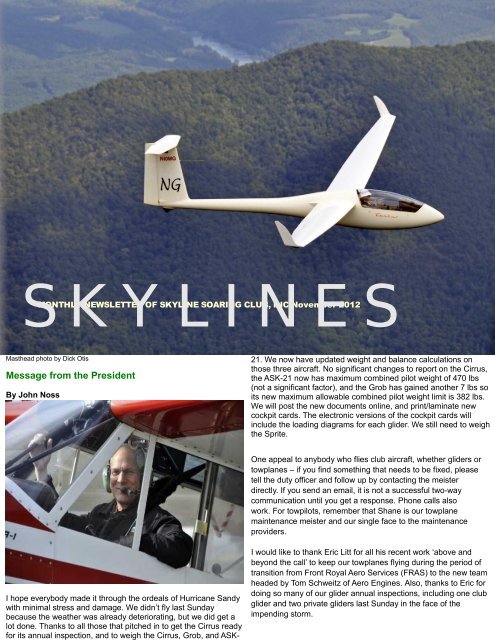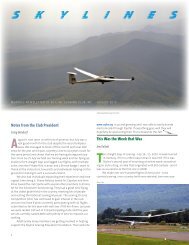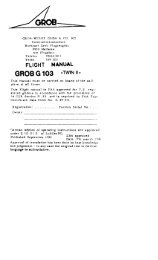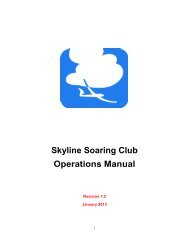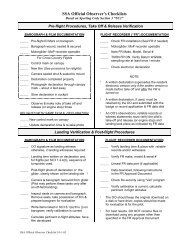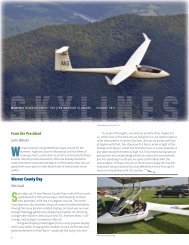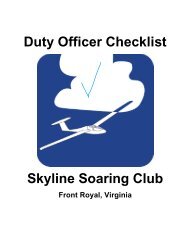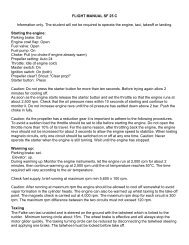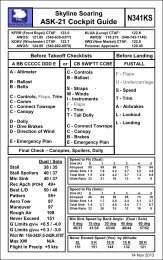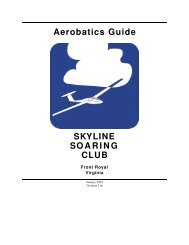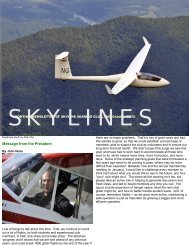Message from the President - Skyline Soaring Club
Message from the President - Skyline Soaring Club
Message from the President - Skyline Soaring Club
You also want an ePaper? Increase the reach of your titles
YUMPU automatically turns print PDFs into web optimized ePapers that Google loves.
S K Y L I N E S<br />
MONTHLY NEWSLETTER OF SKYLINE SOARING CLUB, INC November 2012<br />
Mas<strong>the</strong>ad photo by Dick Otis<br />
<strong>Message</strong> <strong>from</strong> <strong>the</strong> <strong>President</strong><br />
By John Noss<br />
21. We now have updated weight and balance calculations on<br />
those three aircraft. No significant changes to report on <strong>the</strong> Cirrus,<br />
<strong>the</strong> ASK-21 now has maximum combined pilot weight of 470 lbs<br />
(not a significant factor), and <strong>the</strong> Grob has gained ano<strong>the</strong>r 7 lbs so<br />
its new maximum allowable combined pilot weight limit is 382 lbs.<br />
We will post <strong>the</strong> new documents online, and print/laminate new<br />
cockpit cards. The electronic versions of <strong>the</strong> cockpit cards will<br />
include <strong>the</strong> loading diagrams for each glider. We still need to weigh<br />
<strong>the</strong> Sprite.<br />
One appeal to anybody who flies club aircraft, whe<strong>the</strong>r gliders or<br />
towplanes – if you find something that needs to be fixed, please<br />
tell <strong>the</strong> duty officer and follow up by contacting <strong>the</strong> meister<br />
directly. If you send an email, it is not a successful two-way<br />
communication until you get a response. Phone calls also<br />
work. For towpilots, remember that Shane is our towplane<br />
maintenance meister and our single face to <strong>the</strong> maintenance<br />
providers.<br />
I hope everybody made it through <strong>the</strong> ordeals of Hurricane Sandy<br />
with minimal stress and damage. We didn’t fly last Sunday<br />
because <strong>the</strong> wea<strong>the</strong>r was already deteriorating, but we did get a<br />
lot done. Thanks to all those that pitched in to get <strong>the</strong> Cirrus ready<br />
for its annual inspection, and to weigh <strong>the</strong> Cirrus, Grob, and ASK-<br />
I would like to thank Eric Litt for all his recent work ‘above and<br />
beyond <strong>the</strong> call’ to keep our towplanes flying during <strong>the</strong> period of<br />
transition <strong>from</strong> Front Royal Aero Services (FRAS) to <strong>the</strong> new team<br />
headed by Tom Schweitz of Aero Engines. Also, thanks to Eric for<br />
doing so many of our glider annual inspections, including one club<br />
glider and two private gliders last Sunday in <strong>the</strong> face of <strong>the</strong><br />
impending storm.
It’s a recurring <strong>the</strong>me, we really do depend on great work by<br />
volunteers, and it is especially wonderful when somebody does<br />
something needed without having <strong>the</strong>ir arm twisted. Jim Kellett<br />
didn’t have to set up <strong>the</strong> recent Spin Clinic at Shenandoah Valley<br />
<strong>Soaring</strong>, but he did, and it was a great success. A year or two ago,<br />
Joe Parrish didn’t have to copy all of <strong>the</strong> critical aircraft documents<br />
and get <strong>the</strong>m posted online, but as we found last week, it really<br />
makes life easier when you can get to <strong>the</strong> information you need<br />
online. Mike Christensen just donated a storage locker and with<br />
help <strong>from</strong> Dick Garrity got it to <strong>the</strong> hangar, so we now will have a<br />
dedicated parts locker for each aircraft, and thanks to Ertan Tete<br />
we will have a standing spare parts inventory for each aircraft. Go<br />
volunteers!<br />
It was my good fortune, while visiting our daughter Guinevere and<br />
her husband Josh (both <strong>Skyline</strong> members), to check out Greg Cole<br />
and Windward Performance in Bend, OR, which is located just four<br />
miles <strong>from</strong> <strong>the</strong>ir house. (Not a bad place to buy a house,<br />
Gorgeous and Josh!) We spent about two hours <strong>the</strong>re. We were<br />
treated royally by Greg Cole, owner and Chief Engineer. The<br />
sophistication and far reaching implications of <strong>the</strong> technology we<br />
saw was overwhelming. The mystery which still puzzles us is why<br />
hasn’t <strong>the</strong> stuff he is doing caught on in <strong>the</strong> soaring world<br />
Windward Performance has a ten year history as a reputable and<br />
record setting high technology company. It is producing gliders<br />
that clearly are ahead of <strong>the</strong>ir time, and clearly better than literally<br />
any o<strong>the</strong>rs in <strong>the</strong> world. Plus it is all happening right here in<br />
America. He should be selling fistfuls of sailplanes not just in <strong>the</strong><br />
US but world-wide. Yet <strong>the</strong>ir production line now has plenty of<br />
capacity for new orders. Seven Duck Hawks have been sold so<br />
far and <strong>the</strong>re are 32 Sparrow Hawks on wing. The DuckHawk<br />
sales are slowly increasing but <strong>the</strong> SparrowHawks are completely<br />
stagnant! Greg blames it on <strong>the</strong> economy. Maybe <strong>the</strong>re is room<br />
for additional marketing emphasis. At any rate, here is a look at<br />
<strong>the</strong> three sailplane models we saw. By <strong>the</strong> way, <strong>the</strong>re is a fourth<br />
which is yet to be built, <strong>the</strong> GosHawk, a self launching two place<br />
sailplane with an L/D of 37:1. In powered cruise it will get about<br />
150 mpg at 100 mph!<br />
The DuckHawk<br />
Photo by John Noss<br />
The season is winding down, but <strong>the</strong>re are plenty of great soaring<br />
days left before <strong>the</strong> last day of scheduled ops on 16 December,<br />
and even after that we will fly when wea<strong>the</strong>r permits and sufficient<br />
interest can be generated. Our current plan for <strong>the</strong> last day of ops<br />
is to make it a holiday season social event, with a pot-luck<br />
ga<strong>the</strong>ring at <strong>the</strong> terminal building, more details to follow. Plan to<br />
come out and fly and have a good time.<br />
Fly Safe, Fly Often, Have Fun!<br />
Windward Performance Visit<br />
By Bill Burner<br />
Design emphasis is speed without sacrificing climb performance.<br />
Speed is obviously necessary for racing, and penetration. But,<br />
Greg emphasizes, running straight out is only half of a soaring<br />
cycle. The o<strong>the</strong>r half is climb. A sailplane that wastes time<br />
climbing gives away its speed advantage and its competitive edge.<br />
Because of structural limitations of <strong>the</strong> fiberglass currently used by<br />
all o<strong>the</strong>r sailplane designers (e.g. <strong>the</strong> Germans) <strong>the</strong>y are all forced<br />
to trade off climb performance for speed, or vice versa. Windward<br />
minimizes this compromise by <strong>the</strong> use of ultra high strength preimpregnated<br />
oven cured uni and bidirectional carbon fiber. The<br />
DuckHawk structure is almost completely constructed in this<br />
wonderful material. This allows high aspect ratio, extremely thin<br />
wings and clearly superior aerodynamics. To contrast, German<br />
sailplanes use a room temperature curing system, often with a<br />
post cure. The new German sailplanes, particularly <strong>the</strong> recent<br />
racing designs, do use a lot of carbon fiber in <strong>the</strong>ir construction.<br />
Windward uses an oven cured prepreg system that is a very high<br />
quality aerospace grade product. The cured composite has a Tg<br />
(glass transition temperature) of 250 DEG F wet to 290 DEG F<br />
dry. The bonding adhesive is also special and has equally good
high temperature performance (also used in planes like <strong>the</strong> F22).<br />
Materials like this are costly, but very strong and stable. This is<br />
some of <strong>the</strong> strongest aerospace grade construction material<br />
available – stronger even than <strong>the</strong> carbon fiber being used by <strong>the</strong><br />
race community at Reno. It is much stronger than <strong>the</strong> fiberglass<br />
which is used in European or any o<strong>the</strong>r gliders. With it Windward<br />
is producing true state-of-<strong>the</strong>-art sailplanes. Having only a single,<br />
15 meter wingspan <strong>the</strong> DuckHawk is competitive in 3 race classes.<br />
Could a 15 meter sailplane compete against 18 meter and open<br />
class gliders Check out <strong>the</strong> final results at this year's Open Class<br />
Nationals! On Day # 6 <strong>the</strong> DuckHawk and a Schempp-Hirth Arcus<br />
started <strong>the</strong>ir final glide at <strong>the</strong> same time, <strong>from</strong> <strong>the</strong> same altitude,<br />
with <strong>the</strong> Duck Hawk 1.1 nautical miles in trail. This became <strong>the</strong><br />
much anticipated “side-by-side” mano-a-mano fly-off against a<br />
German high tech machine. Flying down <strong>the</strong> same glide slope <strong>the</strong><br />
Duck Hawk made up <strong>the</strong> 1.1 mile gap, catching <strong>the</strong> Arcus in only<br />
10 miles. Case closed. The Duck Hawk is available in three<br />
models, which differ only in <strong>the</strong> strength of <strong>the</strong> spar and o<strong>the</strong>r<br />
structural members. Vne ranges <strong>from</strong> 168 KTS (smooth air) to<br />
225 KTS (smooth air), for <strong>the</strong> heaviest - by 65 lbs - VNX max<br />
performance racer model. 225 KTS is 259 mph and this limit is<br />
good to 24,000 FT! Loads on manually actuated flaps would be<br />
significant at <strong>the</strong> higher DuckHawk speeds. So <strong>the</strong> DuckHawk is<br />
equipped with electric flaps. An additional advantage of electric<br />
flaps is that <strong>the</strong> pilot can select automatic scheduling of <strong>the</strong> flaps<br />
by a flight computer, as a function of airspeed, etc (this is in <strong>the</strong><br />
design stage). The computer’s near instantaneous flap<br />
adjustments will be a big factor in optimizing climb performance<br />
when entering a <strong>the</strong>rmal. It will also decrease <strong>the</strong> pilot workload at<br />
a time when he needs to be concentrating on centering <strong>the</strong><br />
<strong>the</strong>rmal and avoiding gaggle traffic. The G limit is placarded at<br />
11gs. With that kind of a flight envelope <strong>the</strong> DuckHawk is<br />
designed for much more distant horizons than just racing.<br />
Consider <strong>the</strong> aerobatic potential of this glider! Greg is interested in<br />
exploring dynamic soaring, a whole new frontier that is currently<br />
accessed almost exclusively by radio controlled model gliders.<br />
Those small, extremely sturdy gliders are now building up to<br />
speeds well over 400 mph, by flying repetitive, tightly closed<br />
circuits in <strong>the</strong> small airspace on <strong>the</strong> lee side of ridges. No o<strong>the</strong>r<br />
manned sailplane comes close to <strong>the</strong> performance requirements<br />
that it appears dynamic soaring dictates. Greg wants to find out,<br />
with <strong>the</strong> DuckHawk, how feasible dynamic soaring is for manned<br />
flight. Greg states <strong>the</strong> obvious: this is a glider built for <strong>the</strong> future.<br />
In ten years it will be using instruments for dynamic soaring, and<br />
who knows what else, that have not even been invented yet.<br />
Whereas <strong>the</strong> design premise of <strong>the</strong> DuckHawk is ultimate<br />
optimization of speed and climb, thru <strong>the</strong> use of high strength prepreg<br />
oven cured carbon fiber, <strong>the</strong> premise of <strong>the</strong> SparrowHawk is<br />
practicality and fun. Again, Windward takes advantage of <strong>the</strong><br />
extraordinary strength of prepreg oven cured carbon fiber this time<br />
designed to produce a small, light weight sailplane with club class<br />
performance. Amazingly, <strong>the</strong> tiny (11 meter wing span)<br />
SparrowHawk uses basically <strong>the</strong> same commodious fuselage as<br />
<strong>the</strong> DuckHawk. Yet it weighs in at only 155 pounds – not <strong>the</strong><br />
fuselage; <strong>the</strong> whole glider weighs just 155 pounds, empty! Rigging<br />
it is a breeze, and slipping it into a small field on an out landing will<br />
be much easier than any o<strong>the</strong>r fiberglass sailplane. Can’t get a<br />
trailer into <strong>the</strong> field to bring it home No problem! You could<br />
almost put <strong>the</strong> wings in your hip pockets and carry <strong>the</strong> fuselage out<br />
by yourself… well, almost. With a min sink of 119 FPM (at 38 Kts)<br />
it would be easy to call this glider a floater. But Greg resists that<br />
appellation. Its wing loading of up to almost 6 pounds per square<br />
foot and L/D of 37:1 means that this little butterfly can really zip<br />
along! It can penetrate, run straight out, and hold its own against<br />
any club class (fixed gear, no flaps, 15m) sailplane. With a large<br />
well ventilated cockpit, fea<strong>the</strong>r light controls, high maneuverability<br />
(45 – 45 degree roll reversal in 2 seconds), authoritative rudder,<br />
and exceptionally benign stall characteristics this plane is a pure<br />
joy to fly. Ask any one of <strong>the</strong> thirty two owners. This glider is<br />
equally appropriate for a student’s first single seat flight or for<br />
standard class competition. Why has no one else come up with<br />
such a glider Again, <strong>the</strong> Windward advantage is <strong>the</strong> ultra high<br />
strength pre-preg oven cured carbon fiber material which no o<strong>the</strong>r<br />
manufacturer uses.<br />
The SparrowHawk:<br />
The Perlan Project
How would one define <strong>the</strong> ultimate end of <strong>the</strong> performance<br />
spectrum, for winged manned flight Most sailplane designers<br />
would probably be thinking in terms like a little faster, a little higher<br />
L/D, longer wings. Not Windward. Greg’s current horizon is<br />
90,000 feet and Mach 0.3. The Perlan glider which Greg is<br />
confident can reach that altitude by flying stratospheric mountain<br />
waves, already exists. Almost all of <strong>the</strong> pieces have been<br />
fabricated. They are positioned in huge jigs in his shop at Bend,<br />
Oregon, awaiting final assembly. Greg gets serious when<br />
discussing this challenge. “If we cannot agree that a rapid<br />
decompression at 90,000 feet would be fatal <strong>the</strong>n we might as well<br />
stop talking now.” Having looked at <strong>the</strong> problems of full pressure<br />
suits, which Steve Fossett and Einar Enevoldson experienced on<br />
<strong>the</strong>ir record flight to 50,000+, <strong>the</strong> Perlan team has decided that<br />
those suits are not practical for a longer duration flight to 90K.<br />
Unlike U-2 and SR-71 pilots, who use <strong>the</strong> same suits but not fully<br />
inflated, at 90K <strong>the</strong> suits would be as rigid as <strong>the</strong> ones astronauts<br />
use during extra vehicular activities. The suits are so cumbersome<br />
when inflated that <strong>the</strong> pilot cannot even touch his hands to each<br />
o<strong>the</strong>r. Even <strong>the</strong> smallest movements are a major effort. Their<br />
hands are of little more use than clubs. Steve and Einar had to<br />
have a large, cantelope sized ball on <strong>the</strong> top of <strong>the</strong> control stick so<br />
that <strong>the</strong>y could reach it with ei<strong>the</strong>r hand. Hence <strong>the</strong> Perlan attempt<br />
to 90K will be made in a pressurized cabin without back up<br />
pressure suits. No decompression allowed! There will be a lot<br />
riding on <strong>the</strong> structural strength of <strong>the</strong> pressure hull, but that has<br />
already been proven. The project needs about a million dollars to<br />
go on. Greg points out that that amounts to a tax deductible<br />
donation of $1,000 each, <strong>from</strong> a thousand glider pilots. Windward<br />
is considering offering placards citing such a donation which would<br />
be on board <strong>the</strong> Perlan during its historic flight and <strong>the</strong>n visible to<br />
<strong>the</strong> public once it goes on display in <strong>the</strong> Air and Space Museum, or<br />
wherever it winds up. The Perlan project is open to additional pilot<br />
sponsors, who would fly on <strong>the</strong>se historic missions. Yes… it could<br />
possibly be you, for a substantial donation! Greg says much of <strong>the</strong><br />
soaring world sees this as an American project, since it is located<br />
in Bend. But it is a project that <strong>the</strong> whole soaring world will take<br />
pride in. The project is a lot fur<strong>the</strong>r along than we realized. The<br />
technology issues have been addressed and all <strong>the</strong> plane’s<br />
components are finished. It is basically ready for final assembly.<br />
Most of <strong>the</strong> funding is needed for <strong>the</strong> actual attempt itself. Testing<br />
is a real problem. There are no tow planes that can take <strong>the</strong><br />
Perlan to altitude for test flights, so <strong>the</strong> record attempt(s) will also<br />
serve as <strong>the</strong> flight testing. This turns <strong>the</strong> record challenge into a<br />
major expedition – to Argentina, probably, or New Zealand. That is<br />
how most of <strong>the</strong> money will be spent. Why not soar to an even<br />
100,000 ft Greg believes that <strong>the</strong> wave could take <strong>the</strong> Perlan that<br />
high. But <strong>the</strong> aerodynamics get really tough above 90K. In<br />
explaining this out came a bunch of Reynolds numbers,<br />
temperature gradients, Mach numbers, flutter problems etc., that<br />
left us weak kneed and humbled. Bottom line is that building a<br />
transonic or supersonic glider is not in <strong>the</strong> cards. It may be in<br />
Greg’s fertile mind, but it is not within <strong>the</strong> budget constraints that<br />
Windward is working under. Frankly, we were thrilled just to walk<br />
among <strong>the</strong> components that are someday going to 90K and feel<br />
that we were, well not part of history but at least watching history<br />
in <strong>the</strong> making. Even in pieces and with an unfinished coat <strong>the</strong><br />
Perlan is breathtakingly beautiful. What a thrill it will be to see it<br />
take wing!<br />
Greg Cole<br />
You would probably guess that <strong>the</strong> driving force behind <strong>the</strong><br />
extraordinary stuff we saw at Windward is some kind of a super<br />
intellectual, wild eyed unapproachable nerdy engineer incapable of<br />
forming sentences that are not half filled with numbers and<br />
equations, and with a business mind like a steel trap. A modern<br />
day, more practically oriented Einstein. What else could possibly<br />
put something like Windward Performance toge<strong>the</strong>r and achieve<br />
what it already has That is not Greg Cole. He comes across as<br />
an ordinary guy who appears to be in his mid 30s (but that cannot<br />
be true), affable, easy to talk to, generous with his time, and<br />
genuinely enthused with what he is doing. A next door kind of guy<br />
whom it would be fun to drink a beer with and talk about sports, or<br />
whatever. He spent a couple of hours with us. He was not at all
hurried, patient with our questions and informal. At <strong>the</strong> end we got<br />
to talking about families and it emerged that he is as enthusiastic<br />
about his two adopted sons as he is about <strong>the</strong> works of Windward.<br />
He and his wife, Neva, journeyed to <strong>the</strong> fur<strong>the</strong>st outreaches of<br />
nor<strong>the</strong>ast Siberia (seven hours <strong>from</strong> Vladivostok) to pick <strong>the</strong>m up<br />
<strong>from</strong> an orphanage. He talked about how he and Neva went over<br />
<strong>the</strong>re “all in.” They were fully committed to adopting <strong>the</strong> boys even<br />
before first meeting <strong>the</strong>m. The story of <strong>the</strong> previous life of <strong>the</strong>ir<br />
sons, who are bro<strong>the</strong>rs, is tragic. It has been <strong>the</strong> thrill of a lifetime<br />
to watch <strong>the</strong>m make <strong>the</strong> slow and still, after two years, difficult<br />
transition into <strong>the</strong>ir new lives. It has been a series of challenges<br />
for Greg and Neva, but one <strong>the</strong>y enjoy and are dedicated to. It<br />
was clear to us that Greg has as much to look forward to when he<br />
goes home after a day at Windward as he does in <strong>the</strong> morning<br />
going back to work.<br />
A Quick Tour of <strong>the</strong> PowerFLARM<br />
gaggle). However, if <strong>the</strong>y change course and a collision threatens,<br />
it will <strong>the</strong>n alert both pilots of <strong>the</strong> impending problem. Similarly, two<br />
gliders relatively far apart but pointed towards each o<strong>the</strong>r and<br />
moving quickly will result in an alert going off at a fair distance,<br />
typically enough to give <strong>the</strong> pilots 20 seconds to take action.<br />
This advanced and intelligent technology makes FLARM <strong>the</strong> most<br />
interesting part of what PowerFLARM offers. Unfortunately,<br />
PowerFLARM is <strong>the</strong> only device available in <strong>the</strong> US which speaks<br />
FLARM, and so <strong>the</strong> odds of ano<strong>the</strong>r glider also being equipped<br />
with FLARM is remote. This capability remains somewhat<br />
<strong>the</strong>oretical for now, although I anticipate that it will proliferate<br />
rapidly in contests and o<strong>the</strong>r places where close-quarters flying is<br />
common. I certainly hope it will, at least, because this technology<br />
will save lives if widely adapted.<br />
ADS-B<br />
By Mike Ash<br />
The PowerFLARM is an exciting new anti-collision device now<br />
available for gliders in <strong>the</strong> US. Jim Kellett and I pre-ordered one<br />
when <strong>the</strong>y were first announced about two years ago, and after<br />
many delays, we finally received our unit this summer and got it<br />
installed last month.<br />
What exactly is PowerFLARM It's actually three anti-collision<br />
devices in one. It includes <strong>the</strong> proprietary FLARM technology,<br />
developed specifically for gliders and light aircraft in Europe, as<br />
well as an ADS-B receiver and <strong>the</strong> equivalent functionality to a<br />
PCAS device.<br />
FLARM<br />
The FLARM functionality is simultaneously <strong>the</strong> most and least<br />
interesting part of <strong>the</strong> device. A FLARM device contains a GPS<br />
receiver and a low-power digital radio. The FLARM unit broadcasts<br />
its current position, as determined by <strong>the</strong> GPS, as well as a<br />
prediction of its flight path out to about 20 seconds into <strong>the</strong> future.<br />
O<strong>the</strong>r FLARM receivers within a few miles will receive <strong>the</strong>se<br />
broadcasts. They can compare <strong>the</strong> o<strong>the</strong>r traffic's position and<br />
predicted course with <strong>the</strong>ir own, and sound <strong>the</strong> alarm if it looks like<br />
a collision is imminent.<br />
FLARM was designed <strong>from</strong> <strong>the</strong> start with gliders in mind. It<br />
understands <strong>the</strong> kind of flying we do, and is smart enough to avoid<br />
sounding an alarm when two gliders are nearby but not on a<br />
collision course (e.g. hanging out happily on opposite sides of a<br />
In addition to FLARM, <strong>the</strong> PowerFLARM device also features an<br />
ADS-B receiver. ADS-B is conceptually a bit like FLARM, except<br />
higher powered and without <strong>the</strong> advanced flight path prediction<br />
and collision-avoidance smarts. It's eventually intended to be <strong>the</strong><br />
primary surveillance technology in US airspace, although adoption<br />
is not moving particularly quickly. It's hard to find aircraft equipped<br />
with an ADS-B transmitter in <strong>the</strong> US at <strong>the</strong> moment, but for those<br />
that exist, PowerFLARM will detect <strong>the</strong>m and provide collision<br />
alerts much like <strong>the</strong> FLARM functionality.<br />
Transponders<br />
Since most aircraft in this country don't have ei<strong>the</strong>r FLARM or<br />
ADS-B, <strong>the</strong> PowerFLARM provides a final fallback mechanism in<br />
<strong>the</strong> form of a PCAS-like system. This system simply detects<br />
transmissions <strong>from</strong> <strong>the</strong> radar transponders which have been a<br />
feature of <strong>the</strong> air traffic control system for decades. Note that it<br />
does not interrogate transponders, which would require a far larger<br />
and more expensive box. It requires some o<strong>the</strong>r source of<br />
interrogations, such as a ground radar facility or an airliner's TCAS<br />
system. We're never far <strong>from</strong> such a source where we fly, as <strong>the</strong><br />
airliners going overhead are constantly interrogating nearby<br />
transponders.<br />
Transponders provide altitude, but not position or range. Radar<br />
systems figure out position and range by moving <strong>the</strong>ir antenna and<br />
timing <strong>the</strong> delay in responses. The PowerFLARM doesn't have this<br />
luxury, as it's an entirely passive device when it comes to<br />
transponders. Because of this, it can tell how high a transponder<br />
target is (and thus how far away <strong>from</strong> your own altitude it is), but it<br />
can't precisely determine whe<strong>the</strong>r it's a collision threat. The<br />
PowerFLARM makes a rough guess at distance based on <strong>the</strong><br />
signal strength. As <strong>the</strong> remote transponder gets closer, it also gets<br />
louder, and <strong>the</strong> PowerFLARM will use this to guess at how far<br />
away it might be. When it comes to direction, <strong>the</strong> PowerFLARM<br />
has no idea whatsoever. When a transponder-based collision alert<br />
sounds, it will tell you whe<strong>the</strong>r you need to look up, down, or level,<br />
and give you some idea of <strong>the</strong> distance, but it's up to you and your<br />
trusty eyeballs to scan your surroundings and find <strong>the</strong> thing.<br />
Despite <strong>the</strong> limitations, <strong>the</strong> PowerFLARM still shows <strong>the</strong> same<br />
smarts with transponders as with <strong>the</strong> o<strong>the</strong>r systems. If <strong>the</strong> altitude<br />
separation isn't converging, <strong>the</strong>n it won't sound an alarm. Likewise<br />
if <strong>the</strong> target's distance is holding steady or increasing. Only targets<br />
which are closing and at or moving toward a similar altitude trigger<br />
an alarm.<br />
Additional Functionality<br />
Besides its primary role, <strong>the</strong> PowerFLARM can also provide GPS
Why did <strong>the</strong>se folks make <strong>the</strong> long journey for spin training Aren’t<br />
data to o<strong>the</strong>r instruments, PDAs, etc. Although not yet available,<br />
<strong>the</strong> PowerFLARM will also provide an IGC-approved flight logging<br />
facility, good for badges, OLC, etc.<br />
Installation<br />
I highly encourage as many glider pilots as possible to equip <strong>the</strong>ir<br />
aircraft with PowerFLARM units. They work best when everyone<br />
has <strong>the</strong>m, after all. While not a magic bullet, widespread<br />
installation of <strong>the</strong>se systems could make a significant impact on<br />
safety.<br />
There are two different versions of PowerFLARM available. One,<br />
<strong>the</strong> "brick" is intended to be permanently installed in an aircraft.<br />
The PowerFLARM smarts live in a fairly blank and boring box<br />
which you can stash anyhwere, and it comes with a separate<br />
display module that goes into your instrument panel.<br />
Installation of <strong>the</strong> brick is a bit tricky. It has three separate<br />
antennas (GPS, ADS-B/transponder, and FLARM) which all need<br />
to be positioned some distance away <strong>from</strong> each o<strong>the</strong>r. However,<br />
with a bit of creativity, plastic, and plenty of 3M Dual Lock, it's<br />
entirely doable and not overly difficult. Once installed, <strong>the</strong> system<br />
just does its thing without any manual intervention.<br />
A portable unit is also available. This unit contains everything<br />
necessary in one box, including batteries for internal power<br />
(although it will also accept external power if desired). This can be<br />
attached to <strong>the</strong> top of your glare shield or ano<strong>the</strong>r convenient<br />
location, and easily moved between aircraft if need be.<br />
Real-World Use<br />
We haven't had our PowerFLARM up and running for long, but I've<br />
had a chance to at least get an idea of how it works.<br />
Jim Garrison helped with our installation, and also brought his own<br />
PowerFLARM unit along. Once everything was installed, we fired<br />
up both units and <strong>the</strong>y showed up to each o<strong>the</strong>r just as promised.<br />
It wasn't practical to trigger collision warnings, but each unit<br />
showed <strong>the</strong> o<strong>the</strong>r's relative position and altitude just like it's<br />
supposed to. When a collision doesn't threaten, <strong>the</strong> unit simply<br />
displays <strong>the</strong> position of o<strong>the</strong>r traffic in an unobtrusive manner, for<br />
you to use or ignore as you wish.<br />
The system frequently alerts while sitting on <strong>the</strong> ground, just about<br />
any time a transponder-equipped airplane lands, including our own<br />
tow planes and <strong>the</strong> ASK-21. These false alarms would be<br />
annoying in flight, but are a good illustration of how <strong>the</strong> system<br />
works when sitting safely on <strong>the</strong> ground.<br />
PowerFLARM is available <strong>from</strong> many online glider equipment<br />
dealers. The cost is $1,695 for <strong>the</strong> portable unit or <strong>the</strong> brick with a<br />
rectangular external display, or $1,845 for <strong>the</strong> brick with a display<br />
that mounts in a 57mm instrument hole.<br />
Spinning on Purpose<br />
By Dan Earnst<br />
In <strong>the</strong> air, it works as advertised. I've yet to test <strong>the</strong> FLARM or<br />
ADS-B functionality while airborne, but <strong>the</strong> transponder detection<br />
works nicely, within <strong>the</strong> limitations of <strong>the</strong> technology. I've picked up<br />
<strong>the</strong> ASK-21 and some ohter light aircraft in <strong>the</strong> area. One<br />
interesting feature of <strong>the</strong> system is that it will display relative<br />
altitude of a transponder target even when it's not a collision<br />
threat, making it trivial to figure out just how much headroom you<br />
have above or below when <strong>the</strong>rmalling with ano<strong>the</strong>r (transponderequipped)<br />
glider at different altitudes. This taught me that I need<br />
some practice at estimating altitude differences, as I was<br />
<strong>the</strong>rmalling below <strong>the</strong> ASK-21 at an altitude difference of what I<br />
would have guessed was about 500ft, but <strong>the</strong> PowerFLARM<br />
assured me it was actually a 1,200ft difference.<br />
Conclusion<br />
PowerFLARM is exciting technology and its arrival in <strong>the</strong> US is<br />
most welcome. Mid-air collisions represent a significant risk for us,<br />
and one that can be tough to mitigate. The Mark-I Eyeball has<br />
many faults and is not entirely ideal as an anti-collision device.<br />
PowerFLARM is not ideal ei<strong>the</strong>r, but adds a significant second<br />
layer of protection.<br />
The wea<strong>the</strong>r did not look at all promising as four <strong>Skyline</strong> members<br />
left <strong>the</strong> parking lot at KFRR and headed south for Eagle’s Nest<br />
Airfield west of Charlottesville for spin training with <strong>the</strong><br />
Shenandoah Valley <strong>Soaring</strong> <strong>Club</strong> (SVS). Low clouds and patches<br />
of fog hung in <strong>the</strong> air most of <strong>the</strong> way down I-81.
spins something you should avoid at all costs Why do it on<br />
purpose Because, as Bob Wander says, “Spins have been with<br />
us since <strong>the</strong> Wright Bro<strong>the</strong>rs and probably always will be.” So it<br />
makes good sense to try a couple under controlled circumstances,<br />
know what <strong>the</strong>y are like and how to recover <strong>from</strong> <strong>the</strong>m. But our<br />
trainers won’t stall and with out a stall you can’t spin, right. Well<br />
you can stall our trainers with a shallow skidding turn, but <strong>the</strong>y are<br />
very difficult to spin. But if you plan to move up to <strong>the</strong> Sprite, it will<br />
stall and it will spin. As will any of <strong>the</strong> high performance ships.<br />
opportunity comes up, Jump on it!<br />
All <strong>the</strong> participants owe a big Thank You to Jim Kellett for setting<br />
this up.<br />
By Evan Dosik<br />
Upon arrival at Eagle’s Nest <strong>the</strong> overcast was still stubbornly<br />
hanging around as our hosts at SVS welcomed us to <strong>the</strong>ir hangar<br />
and temporary classroom. Coffee, doughnuts and pleasant<br />
conversation occupied <strong>the</strong> first half hour. This was so enjoyable<br />
<strong>the</strong> wea<strong>the</strong>r could take its sweet time. Then it was time for our<br />
instructors, <strong>the</strong> CFI-G duo of Graham and Jeanne Pitsenberger, to<br />
start <strong>the</strong> ground school. After a short lecture on <strong>the</strong> hows and whys<br />
of spins, we learned how we were going to be able to spin <strong>the</strong><br />
usually unspinable ASK-21. The nearly new SVS K has a factory<br />
installed capability to add weights to <strong>the</strong> lower vertical stabilitzer to<br />
get <strong>the</strong> required aft CG. Since <strong>the</strong> weights of <strong>the</strong> instructors and<br />
each of <strong>the</strong> students varied, an intensive weight and balance<br />
calculating session ensued to determine how many weights each<br />
of <strong>the</strong> students would need to get <strong>the</strong> aircraft to spin.<br />
As we finished up <strong>the</strong> math and headed for <strong>the</strong> field, <strong>the</strong> clouds<br />
parted and we were treated a stunning fall day in <strong>the</strong> Shenandoah,<br />
ceiling and visibility unlimited. Widely scattered Cu only served to<br />
accentuate <strong>the</strong> blue of <strong>the</strong> shy. The SVS folks set up <strong>the</strong>ir tents<br />
and established ops at <strong>the</strong> approach end of <strong>the</strong> field. Their<br />
distances are a bit shorter than ours and a golf cart works<br />
wonderfully to tow <strong>the</strong> glider on <strong>the</strong> ground. Each student got one<br />
flight with ei<strong>the</strong>r Graham or Jeanne. The CFIs flew <strong>the</strong> take offs<br />
and landings, but turned <strong>the</strong> 4,000 foot tow and <strong>the</strong> rest of <strong>the</strong><br />
flying over to <strong>the</strong> student. Each sortie consisted of a five turn spin,<br />
an insipient spin and recovery both right and left and a steep turn.<br />
The spin was not violent and g force was light. O<strong>the</strong>r than <strong>the</strong> nose<br />
pointed almost straight down and <strong>the</strong> world spinning rapidly, it<br />
didn’t feel too much different than straight and level flight. After five<br />
turns anti-spin controls were applied and <strong>the</strong> glider recovered<br />
quickly with a 3.3G pull out. Insipient spins were quickly recovered<br />
<strong>from</strong> with anti-spin controls and<br />
This was a most pleasant to add spin awareness and recovery to<br />
your bag of flying tricks. The SVS members turned out in force to<br />
support operations and <strong>the</strong>ir hospitality was phenomenal. Graham<br />
and Jeanne are great instructors who imparted knowledge as well<br />
as physical skills. It is always a good thing to visit ano<strong>the</strong>r club and<br />
airfield to learn how things are done differently, like hanging your<br />
gliders <strong>from</strong> <strong>the</strong> hangar beams for storage! Eagle’s Nest is<br />
beautiful place nestled in <strong>the</strong> Shenandoah. So <strong>the</strong> next time this<br />
I was one of <strong>the</strong> 6 “<strong>Skyline</strong>rs” who participated in <strong>the</strong> “Spin Clinic”<br />
hosted by Shenandoah Valley <strong>Soaring</strong> on Friday 10/19 at Eagles<br />
Nest in Waynesboro, VA. We started <strong>the</strong> grey<br />
cloudy day @ 10 AM with an informative ground school presented<br />
by Graham Pitsenberger, and just as we were finishing <strong>the</strong> training<br />
in <strong>the</strong>ir hanger, <strong>the</strong> clouds burned off and were treated to flight<br />
instruction by Graham and his wife Jeanne in <strong>the</strong>ir gorgeous 2009<br />
ASK-21 with a factory spin mod training kit. (More details in <strong>the</strong><br />
attached SVS<br />
newsletter). Besides <strong>the</strong> six who took <strong>the</strong> training (Rob Creedon,<br />
Ertan Tete, Dan Ernst, John Noss, Bruce Zivic, Evan Dosik) Jim<br />
Kellett, who I believed organized <strong>the</strong> training with SVS, and his<br />
wife Pat were also <strong>the</strong>re. A couple of us recorded videos of <strong>the</strong><br />
training flights and will provide <strong>the</strong>m as training tools asap to Jim.<br />
SVS's very cool hanger that’s reminiscent of an exhibit at <strong>the</strong> Air &<br />
Space Museum. Note <strong>the</strong>ir 1-26 and 2-33 space saving storage<br />
and <strong>the</strong> homemade Pawnee peddle car,<br />
painted similar to, and with all instrumentation photo copied <strong>from</strong><br />
<strong>the</strong>ir tow plane!
sing!<br />
Ratings, Badges, Milestones<br />
Chuck Stover completed his silver badge with his distance task<br />
approved and Badge #6907 awarded:<br />
Here is John Seymour looking back at you. (Bruce and Karl)<br />
Turnpoint Exchange<br />
Photo by Chuck Stover - DG200 RW<br />
Recycled<br />
Inforation<br />
Worth<br />
Repeating<br />
SAY AGAIN<br />
This is a picture of yours truly (Bruce Zivic) with Karl Striedieck in<br />
his Duo Discus at 14,000 over Pennsylvania, Karl can smell lift,<br />
vario chirped <strong>the</strong> entire ride. We also flew in formation with John<br />
Seymour for a while, wings tips no fur<strong>the</strong>r than 10 feet apart . In<br />
addition we flew about 3,000 over a Lufthansa craft. I hate it when<br />
great stuff like this happens because its going to be awhile before<br />
it happens again.<br />
I learned to fly at SSC and Karl showed me how to make a bird<br />
By John Noss<br />
For those interested in <strong>the</strong> wealth of information on Lynn Alley's<br />
"Turnpoint Exchange" website, <strong>the</strong>re are some major updates,<br />
including new maps for soaring applications,<br />
at http://www.soaringdata.info .<br />
Additionally, John Leibacher has posted an ‘unofficial’ and<br />
unpublished version of turnpoint data for Front Royal,<br />
at http://soaringweb.org/TP/Front_royal_temp , just for review for<br />
now, comments to me directly please.<br />
Condor Virtual Contest<br />
By Piet Barber<br />
In <strong>the</strong> winter months, when <strong>the</strong> real-outdoor-flying isn't possible for<br />
much of <strong>the</strong> country, many pilots sit around and talk about flying.<br />
The rec.aviation.soaring newsgroup gains traffic, and many<br />
subjects wander off-topic. There aren't any contests to speak of...<br />
...Except for this year! There is actually a contest in late<br />
November -- a Condor Virtual Contest! Check it out.
https://sites.google.com/site/condorthanksgiving/pli=1<br />
This is <strong>the</strong> contest where everybody can afford a Ventus2bx, and<br />
<strong>the</strong> wea<strong>the</strong>r is always perfect for soaring.<br />
I'm mulling joining up and see how well or how badly I fare.<br />
Currently, <strong>the</strong>re are only 2 contestants. The top 3 finishers get a<br />
25 dollar gift certificate <strong>from</strong> Cumulus <strong>Soaring</strong>.<br />
<strong>President</strong> - John Noss<br />
Secretarty – Jim Kellett<br />
Treasurer – Thomas Park<br />
Membership – Steve Rockwood<br />
Chief Duty Officer – Craig Bendorf<br />
Chief Tow Pilot – Martin Gomez<br />
<strong>Skyline</strong> <strong>Soaring</strong> <strong>Club</strong>, Inc.<br />
Is a private, 501(C7) non-profit organization,<br />
Chief Flight Instructor – Piet Barber<br />
Safety Officer - Charles Norman<br />
dedicated to <strong>the</strong> enjoyment and promotion<br />
of <strong>the</strong> sport of soaring. SSC is based at<br />
<strong>the</strong> Front Royal-Warren County, VA. Airport<br />
and is an affiliate club of <strong>the</strong><br />
<strong>Soaring</strong> Society of America<br />
For information about <strong>the</strong> club go to:<br />
<strong>Skyline</strong>s Editor – Douglas Hiranaka<br />
duck_h@hotmail.com<br />
Directors – Daniel Ernst<br />
Mike Christenson, Jim Kellet<br />
John Noss, Thomas Park<br />
www.skyinesoaring.org Steve Rockwood, Ertan Tete


